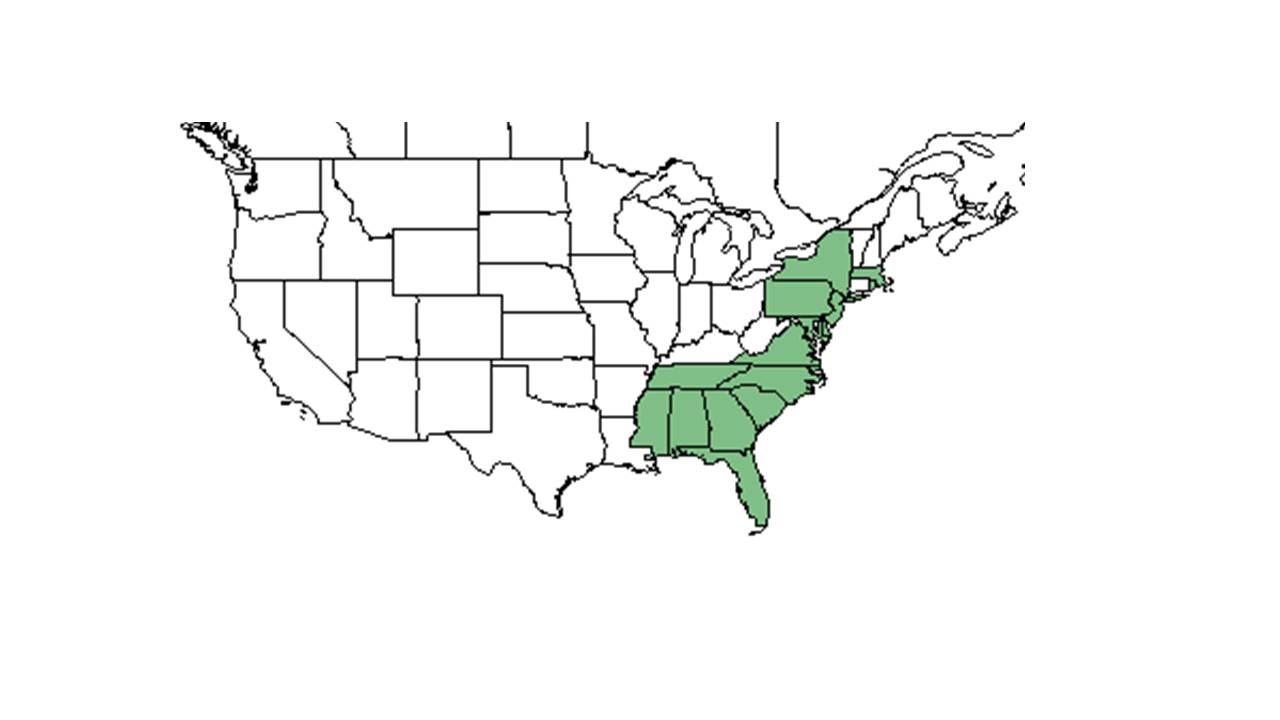Difference between revisions of "Lespedeza angustifolia"
KatieMccoy (talk | contribs) |
KatieMccoy (talk | contribs) |
||
| Line 48: | Line 48: | ||
==Photo Gallery== | ==Photo Gallery== | ||
==References and notes== | ==References and notes== | ||
| − | Florida State University Robert K. Godfrey Herbarium database. URL: [http://herbarium.bio.fsu.edu http://herbarium.bio.fsu.edu]. Last accessed: | + | Florida State University Robert K. Godfrey Herbarium database. URL: [http://herbarium.bio.fsu.edu http://herbarium.bio.fsu.edu]. Last accessed: July 2015 Collectors:Loran C. Anderson, Wilson Baker, A. F. Clewell, James R. Coleman, Delzie Demaree, William B. Fox, J. P. Gillespie, Robert K. Godfrey, Gary R. Knight, R. Komarek, R. Kral, T. MacClendon, John Morrill, A. E. Radford, John K. Small States and Counties: Alabama: Baldwin. Florida: Franklin, Jackson, Jefferson, Leon, Liberty, Madison, Nassau, Wakulla, Washington. Georgia: Appling, Baker, Camden, Clinch, Grady, Lowndes, Miller, Seminole, Thomas, Walton, Wilcox. North Carolina: Cumberland, Harnett, Pitt. South Carolina: Sumter. Compiled by Tall Timbers Research Station and Land Conservancy. |
Revision as of 11:55, 16 September 2015
| Lespedeza angustifolia | |
|---|---|

| |
| Scientific classification | |
| Kingdom: | Plantae |
| Division: | Magnoliophyta - Flowering plants |
| Class: | Magnoliopsida – Dicotyledons |
| Order: | Fabales |
| Family: | Fabaceae ⁄ Leguminosae |
| Genus: | Lespedeza |
| Species: | L. angustifolia |
| Binomial name | |
| Lespedeza angustifolia (Pursh) Elliott | |

| |
| Natural range of Lespedeza angustifolia from USDA NRCS Plants Database. | |
Common name: narrowleaf lespedeza
Contents
Description
Distribution
Ecology
"Lespedeza angustifolia was distinctly associated with the more hydric end of the gradient…”[1]
Habitat
It is limited to terrestiral uplands. Habitats include sandhills, pine flatwoods, and oldfield pinelands, as well as dry pond margins and open flood plains on areas that are mesic to excessively well drained. Soils include sand and sandy loams, including Ultisols, Entisols, and dry Spodosols.[2]. Other soil types includes red sandy clay hills and sandy peat (FSU Herbarium). Presence of Imperata cylindrica (cogan grass), an invasive plant found in the southeastern United States, did not deter the occurrence of L. angustifolia in plots that had been burned every 1 to 2 years in southeastern Mississippi.[3] L. angustifolia also appears to be associated with wet areas due to a higher tolerance for periodically inundated soil conditions.[4]. It has been documented to occur in dried up bottoms of sinkhole ponds (FSU Herbarium). In its natural habitat it requires frequent fire for persistence. It is primarily located in undisturbed sites and sometimes colonizes freqeuntly burned old-field pinelands.[5]
L. angustifolia is prevalent along eroded roadsides and railroads (FSU Herbarium).
Species that commonly associated are varieties of Aristida, Ctenium, Andropogon, Sporobolus and Panicum hemitomon (FSU Herbarium).
Phenology
It blooms from September to November. Frequent where present by populations tend to be separated from one another.[5]
Seed dispersal
Seed bank and germination
Lespedeza and other legume species have the hard seed coat. Species with hard seed coats are likely capable of forming long-term persistent seed banks, and continuation of the buried seed bag portion of this study will yield long-term data on this subject.[6] “Although perennial species of longleaf pine ecosystems, such as Lespedeza, persist through frequent fire, fire exposes seeds in soil to higher temperatue and high amplitudes of temperature fluctuation[7], leading in some cases to germination.”[6]
Fire ecology
“White et. al. (1990) reported that frequent dormant season burning increased legume populations in southern pine forests, although fires during the gorwing season at the same frequency tended to reduce legume abundance.”[8]
Pollination
bee andLepidopteran pollinated in chasmogamous flowers afc
Use by animals
Diseases and parasites
Conservation and Management
Cultivation and restoration
Photo Gallery
References and notes
Florida State University Robert K. Godfrey Herbarium database. URL: http://herbarium.bio.fsu.edu. Last accessed: July 2015 Collectors:Loran C. Anderson, Wilson Baker, A. F. Clewell, James R. Coleman, Delzie Demaree, William B. Fox, J. P. Gillespie, Robert K. Godfrey, Gary R. Knight, R. Komarek, R. Kral, T. MacClendon, John Morrill, A. E. Radford, John K. Small States and Counties: Alabama: Baldwin. Florida: Franklin, Jackson, Jefferson, Leon, Liberty, Madison, Nassau, Wakulla, Washington. Georgia: Appling, Baker, Camden, Clinch, Grady, Lowndes, Miller, Seminole, Thomas, Walton, Wilcox. North Carolina: Cumberland, Harnett, Pitt. South Carolina: Sumter. Compiled by Tall Timbers Research Station and Land Conservancy.
- ↑ Hainds, M. J., R. J. Mitchell, et al. (1999). "Distribution of native legumes (Leguminoseae) in frequently burned longleaf pine (Pinaceae)-wiregrass (Poaceae) ecosystems." American Journal of Botany 86: 1606-1614.
- ↑ Clewell, Andre. 2014. Personal observations
- ↑ Brewer, J. S. and S. P. Cralle (2003). "Phosphorus addition reduces invasion of a longleaf pine savanna (southeastern USA) by a non-indigenous grass (Imperata cylindrica)." Plant Ecology 167: 237-245.
- ↑ Hainds, M. J., R. J. Mitchell, et al. (1997). "Legume population dynamics in frequently burned longleaf pine-wiregrass fire ecosystem." Proceedings Longleaf Alliance Conference: Longleaf Alliance Report 1: 82-86. Hainds, M. J., R. J. Mitchell, et al. (1999). "Distribution of native legumes (Leguminoseae) in frequently burned longleaf pine (Pinaceae)-wiregrass (Poaceae) ecosystems." American Journal of Botany 86: 1606-1614.
- ↑ 5.0 5.1 Clewell, Andre. 2014. Personal observations.
- ↑ 6.0 6.1 Coffey, K. L. and L. K. Kirkman (2006). "Seed germination strategies of species with restoration potential in a fire-maintained pine savanna." Natural Areas Journal 26: 289-299.
- ↑ Grime, J.P. 1989. Seed banks in ecological perspective. Pp. xv-xxii in M.A. Leck, V.T.Parker, and R.L. Simpson, eds., Ecology of Soil Seed Banks. Academic Press, San Diego, Calif.
- ↑ Hainds, M. J., R. J. Mitchell, et al. (1997). "Legume population dynamics in frequently burned longleaf pine-wiregrass fire ecosystem." Proceedings Longleaf Alliance Conference: Longleaf Alliance Report 1: 82-86.